One aspect to consider when looking at getting a dog is the climate in which you live.
If you live in a moderate climatic region, you can choose almost any dog breed that suits you. I
f you live where the weather becomes very hot or cold, you must be selective about the dog breed you choose.
Greyhounds, Rhodesian Ridgebacks, Basenjis, German Shorthaired Pointers, and Dachshunds are suited to hot climates. St. Bernards, Newfoundlands, Siberian Huskies, White Swiss Shepherds, and Pomeranians are adapted for the cold. Labradors and German Shepherds are suited to both cold and hot weather.
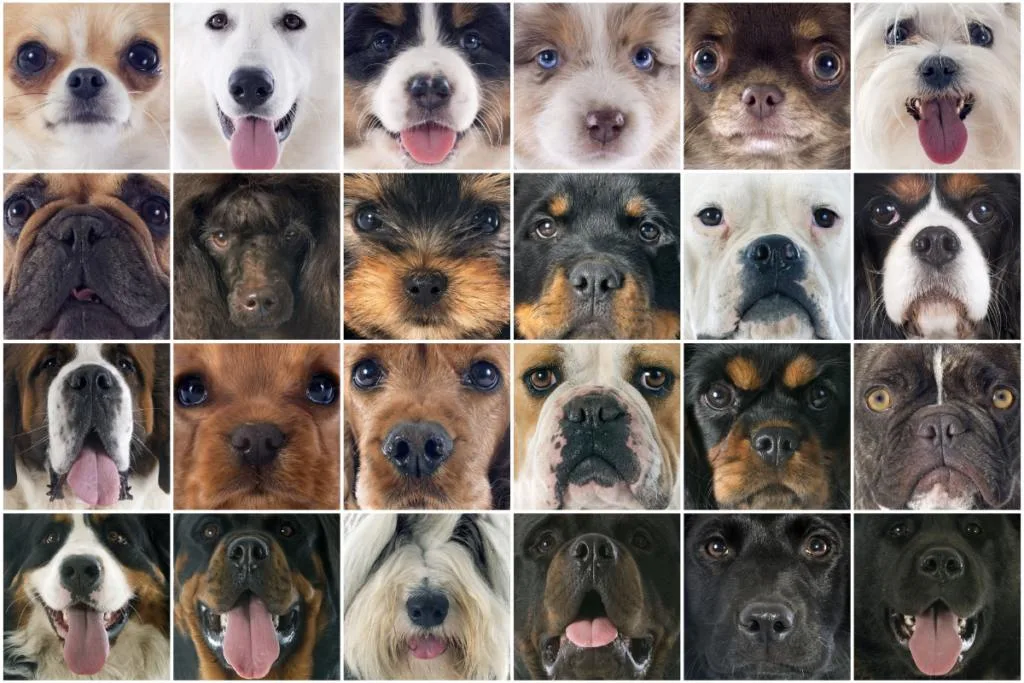
It can be difficult to choose a dog breed best suited to the climatic region where you live.
Having some guidelines and knowledge can make choosing a dog breed less confusing and allow you to pick the best dog for your family.
Click Here to Jump to a Section
Best Dog Breeds For Hot Weather
Dog breeds that cope well with extremely hot temperatures are short-coated with only a single layer to the coat. They have a well-proportioned facial structure allowing them to breathe easily in the heat.
Brachycephalic dogs (short muzzle with squashed face) should not be kept in hot climates.
These dogs include Bulldogs, Pekingese, Pugs, Bull Mastiffs, Boxers, Shih Tzus, Lhasa Apsos, and Boston Terriers.
They suffer from brachycephalic airway syndrome, which is worsened in hot weather.
An important factor in choosing a breed for a hot climate is the potential harm the sun can cause to the dog’s skin.
White dogs with pink skin often develop cancer if they live in hot regions where the UV (ultraviolet) index is high.
Black dogs may also suffer more in the heat as black absorbs all the light spectrum colors.
This will result in the dog feeling the heat more than a brown or alternatively colored dog.
1. Greyhounds
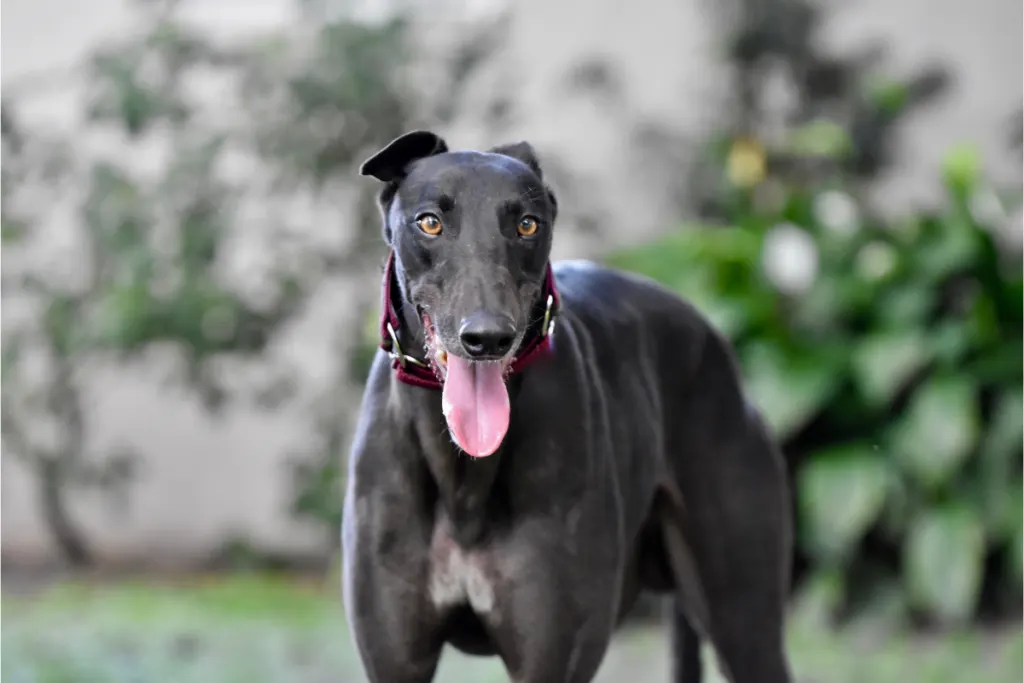
Greyhounds are large dogs standing 27 to 30 inches (66 -76 cm) tall and weighing 60 to 88 pounds (25 – 40 kg).
They are lean muscular sighthounds with an elongated muzzle. They have short single-layer coats that make them heat tolerant.
Many people are convinced that Greyhounds are hyperactive high-energy dogs because they can reach speeds of 43 mph (70km per hour).
Nothing could be further from the truth. Most Greyhounds are happy lazing around and may sleep for 18 hours a day. Their low activity level is ideal for hot climates.
The National Greyhound Adoption Program (NGAP) advises that Greyhounds need one hour of exercise a day. It is best to exercise these hounds in the early morning or late afternoon in hot climates.
They are loving dogs that usually get on well with children and other large dogs. Their docile nature makes them good dogs for first-time dog owners.
They can live happily in apartments as long as they receive their hour of daily exercise.
The cons of Greyhound owning are they have a high prey drive and often chase small animals such as cats or even small dogs. Some have higher hunting instincts than others.
When walking Greyhounds, it is best to keep them leashed. They can take off in a second if they spot an animal they consider prey.
Greyhounds enjoy the opportunity to run, but this should only be allowed in a securely fenced area.
Greyhounds have unusual blood chemistry, and the vet must be familiar with the breed.
They do not metabolize barbiturate anesthetics and are sensitive to some insecticides, so care must be taken when using tick and flea products.
Despite their sensitivities to medicine and flea products, Greyhounds are generally long-lived dogs, with many surviving up to 13 or 14 years.
If you like Greyhounds but prefer a smaller dog, consider a Whippet or Italian Greyhound.
They are from the same family as Greyhounds, sharing the same body type and short coat.
The American Kennel Club (AKC) provides information on the two breeds that can help you choose. Both breeds are well-suited to hot climates.
Source: AKC
You may also enjoy reading more about Greyhounds in the following articles:
German Shepherd Greyhound Mix: Fast and Forever Loyal
What Are The Best Dog Breeds For First Time Owners?
2. Rhodesian Ridgebacks
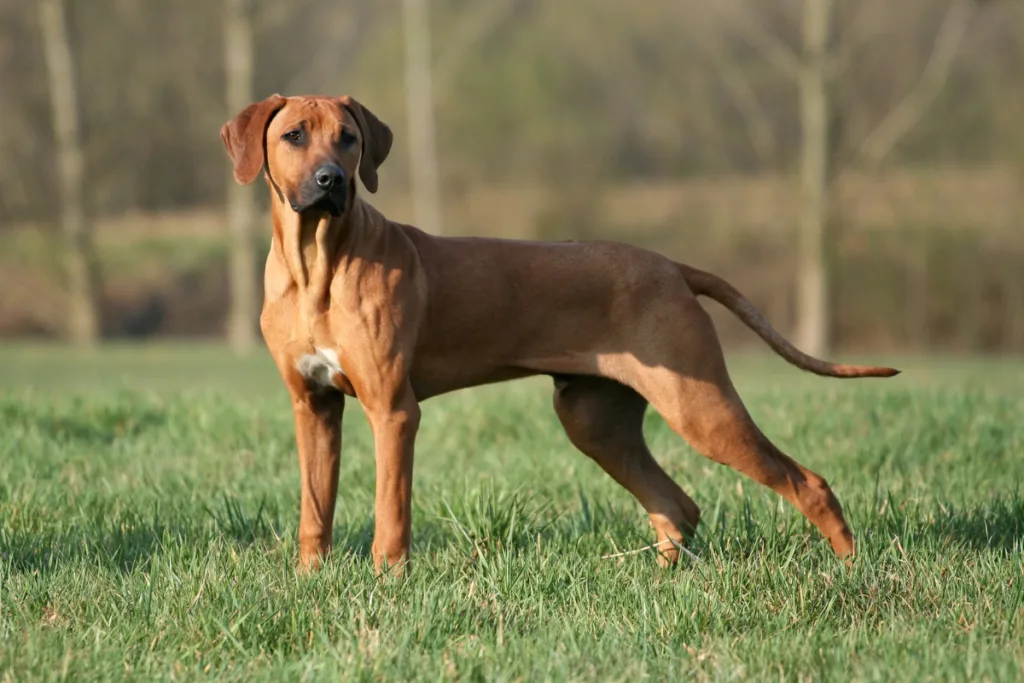
Rhodesian Ridgebacks are large hounds ranging in height from 24 to 27 inches (60 – 69 cm) and weighing 70 to 85 pounds (31 -36 kg).
They are imposing muscular dogs with a ridge of hair that runs the length of their backs.
Ridgebacks come in only one color, which is wheaten. The hue may vary from flaxen to burnished red.
The coat is short, making them suitable for hot climates. They were bred to hunt lions in hot regions of southern Africa, where daily temperatures are often high.
Rhodesian Ridgebacks are a good dog to consider if you want a protective, brave, loyal dog that will take on any threat to its family.
They are excellent with children and thrive on time spent with their people. They are generally aloof with strangers.
They have moderate to high energy needs and are best suited to homes with large yards or farms.
Rhodesian Ridgebacks are well suited to active families. They have a high prey drive and must be taught to leave livestock and cats alone.
Rhodesian Ridgebacks are dominant dogs that need a firm, kind approach. Training is essential as they are willing to take the top spot if the owners leave it vacant.
Due to this characteristic, they are not suitable for first-time dog owners or people who struggle to assert themselves.
3. Basenjis
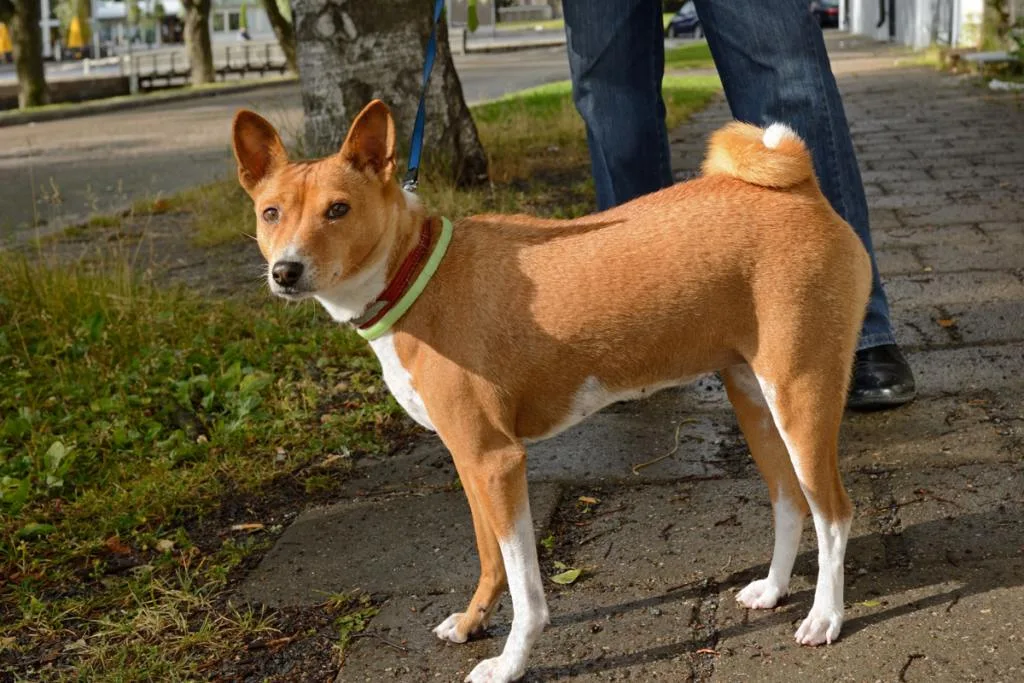
If you live in a scorchingly warm area and want a small-medium-sized dog that is slightly unusual, a Basenji may be just the right dog.
These dogs weigh 20 to 24 pounds (9 – 11 kg) and are 16 to 18 inches (41 – 46 cm) at the shoulder.
Basenjis originate from the swelteringly hot Democratic Republic of the Congo. In order to survive the heat, they were bred with short sleek coats.
Basenjis hate water and avoid getting wet. They have tightly curled tails and wrinkled foreheads.
An interesting feature of Basenjis is that they do not bark. Their larynx is shaped differently from most dogs, producing a yodel instead of barking.
They tend to attach themselves to only one person and are wary of strangers. They have a cat-like ability to climb, making them escape artists.
Basenjis stand on their back legs to get a better view of something that catches their interest, much like meerkats do.
They are not dogs for anyone who likes instant obedience. Basenjis are difficult to train and use their intelligence to solve problems for their own gain.
Basenjis will chase cats and other small animals.
These dogs have an unusual floating trot and are graceful athletes. Many owners state that one of the attractions is the beauty of their movement.
Another reason is their absolute devotion to their owner.
Source: AKC
4. German Shorthaired Pointers
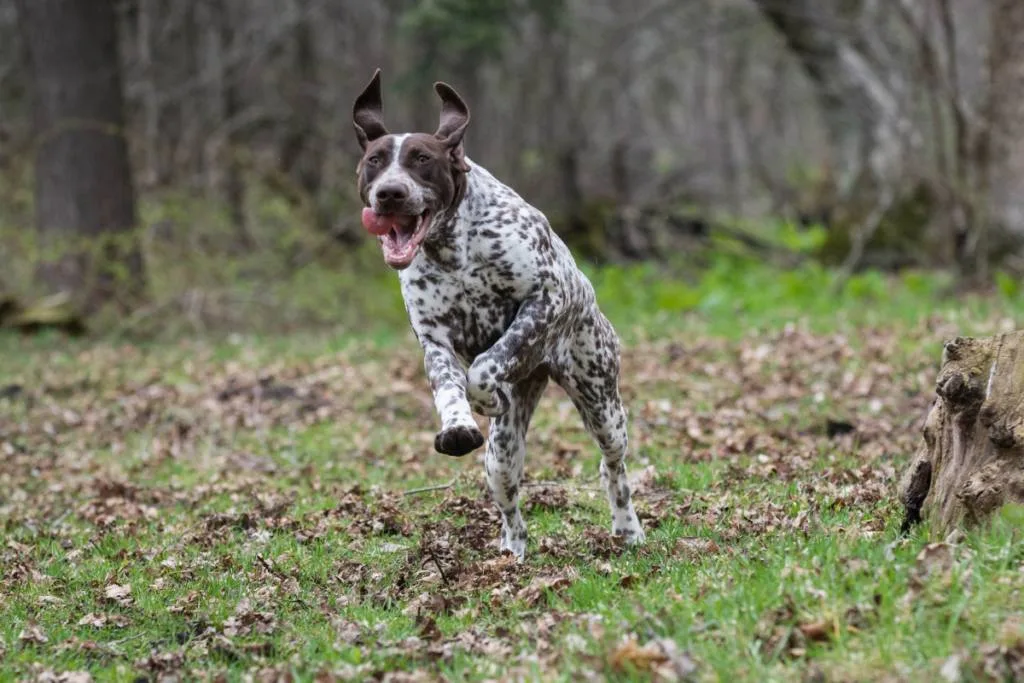
German Shorthaired Pointers (GSP) belong to the gun dog group in the AKC.
Like many gun dogs, they are gentle, kind dogs that adore people.
GSPs are happiest when they are with their family, whether doing a physical activity or lazing around the house.
GSPs are medium-large dogs measuring 21 to 25 inches (53 – 63cm) with weights of 45 to 70 pounds (20 -32 kg).
They have attractively colored short coats allowing them to stay cool in the heat.
Many GSPs enjoy swimming which makes them further suited to hot climates.
The GSP is a high-energy dog that needs training, exercise, and mental stimulation.
They can become destructive if they do not receive sufficient exercise and mental challenges.
As gun dogs, GSPs have a high hunt drive and will chase cats and rabbits.
GSPs are generally good with children but can be too boisterous for toddlers and small children.
5. Dachshunds
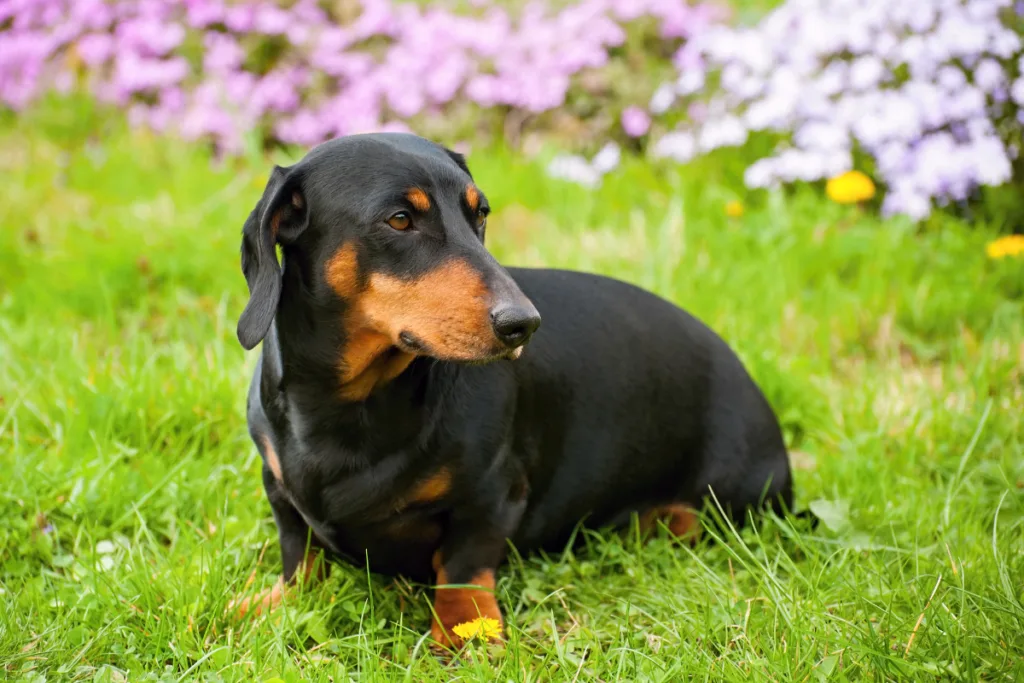
A Dachshund is a good option if you are looking for a small dog breed that can cope well with heat.
Standard Dachshunds are 8 to 9 inches (20 -23 cm) and 16 to 32 pounds (7 – 14 kg). Miniatures are 5 to 6 inches (12 – 15 cm) and weigh less than 11 pounds (5 kg).
Dachshunds have short, smooth coats, although some have long-haired or wirehaired coats. Smooth or wirehaired Dachshunds are the best for hot weather.
Their coats can be a single color, bi-color such as black and tan, or dappled.
These lively, bold little dogs show tremendous courage and will defend their owners with loud barking and ankle-biting if necessary.
They are loyal and easy to train, learning commands and tricks quickly.
Standard Dachshunds are usually better with children than the miniature version.
Miniature Dachshunds are so small they are easily hurt accidentally by children, making them defensive.
They can live comfortably with other dogs but are prone to thinking of themselves as bigger than they are. As a result, Dachshunds are better when paired with gentle, tolerant dog breeds.
Their intelligence makes them suited for first-time dog owners. They can live in smaller homes if they are exercised daily.
They can become nuisance barkers if they do not receive enough exercise and stimulation.
A drawback of the Dachshund breed is that their long body makes them prone to back injuries.
It is best to buy your Dachshund from a reputable breeder that aims to produce healthy dogs that do not have extreme body lengths.
Their long bodies make swimming challenging. If you have a Dachshund in a hot climate, it is best to spray them with water or provide a shallow paddling pool.
Source: Hill’s Pets
Dog Breeds For Cold Climates
Dog breeds that are best suited to icy climates are double-coated.
They have an outer coat made up of long guard hairs that keep out moisture and dirt. The soft insulating undercoat has much finer hairs and helps keep the dog warm.
Double coats have shedding cycles designed to keep the dog warm in winter and cooler in the summer.
These coats should never be clipped or shaved as it interrupts the shedding cycle and can negatively affect the dog’s temperature regulation.
1. Saint Bernards
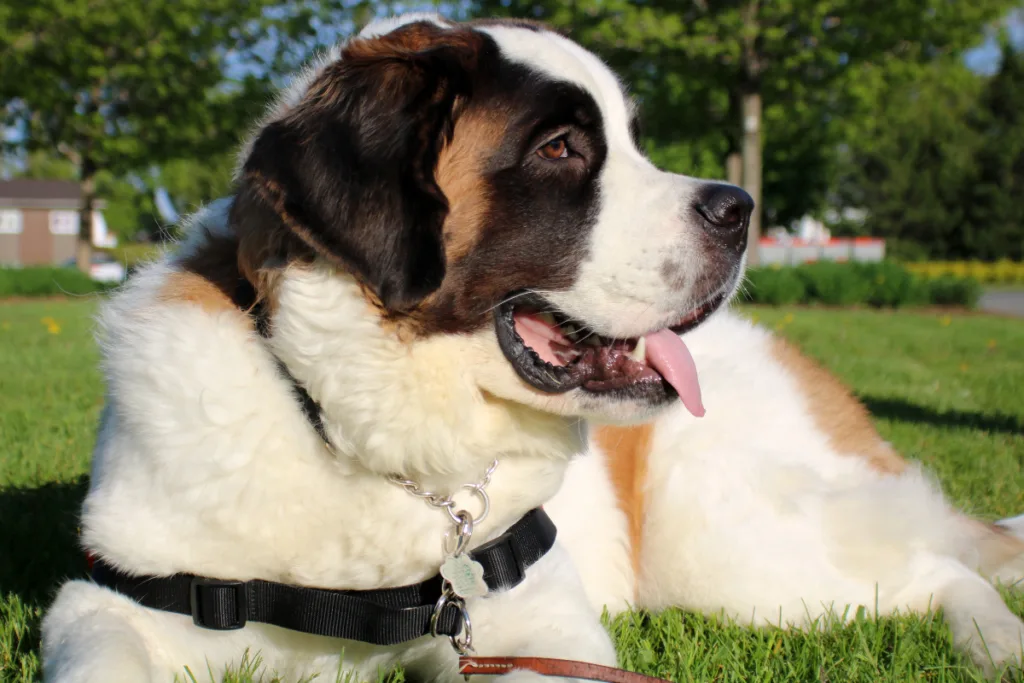
Saint Bernards are giant breed dogs. They measure 25 to 27 inches (63 -67 cm) and weigh 120 to 200 pounds (54 -90 kg).
They are well known for their rescuing abilities in the Swiss Alps. Their thick double coats adequately protected them in the frigid mountain weather.
Although these dogs are extremely large, they are gentle dogs that bond closely with their families.
They generally get on well with dogs and other animals.
Saint Bernards are patient and tolerant with children. Although little ones must be taught to respect the dog as they can hurt it if they jump or ride on it.
The dog will most likely endure the discomfort without snapping or hurting the child.
Saint Bernards drool a lot, and males seem worse than females.
A Saint Bernard is not the right dog for you if you are houseproud or squeamish.
Saint Bernards must be trained. Their enormous size means that without training, vet visits or walks become a circus with the owner being towed behind.
Saint Bernards are eager to please and learn quickly.
It is important to select a responsible breeder as some lines have incorrectly bred aggressive dogs.
This trait is not the breed standard and should never be acceptable.
They are social dogs and want to be part of the family’s activities.
They are also good at pulling sleds and romping in the snow with their owners.
Source: Hill’s Pets
Read more about Saint Bernards here:
The Best Dog Breeds for Children With Autism
2. Newfoundlands
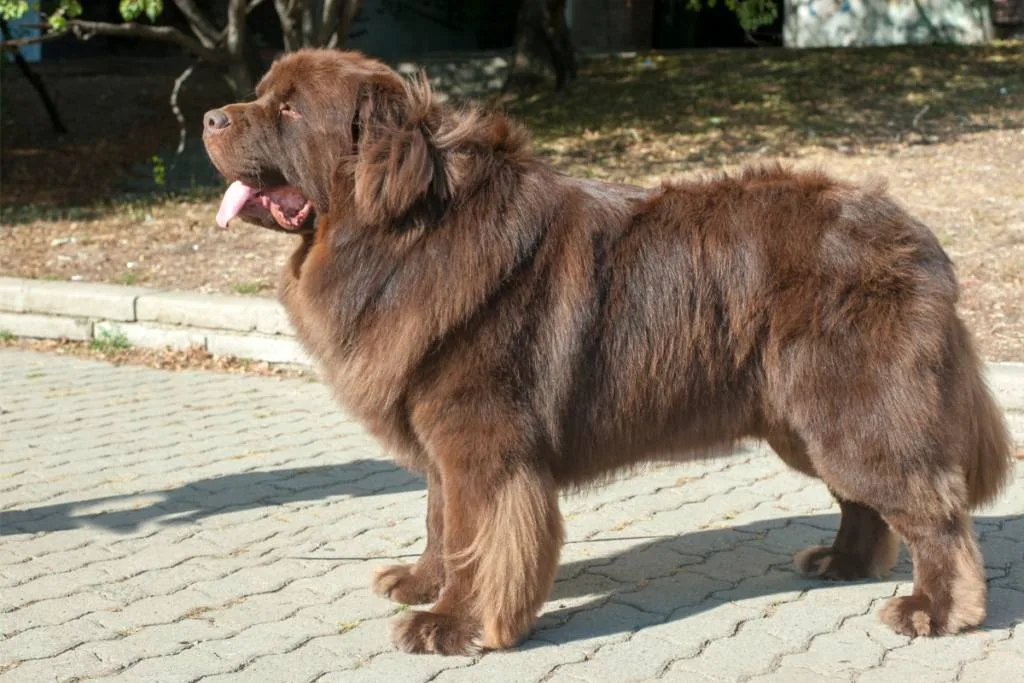
Newfoundlands are also a giant breed, but they originated in the icy regions of Canada.
They have four coat colors; black, brown, grey, or black and white, known as Landseer.
They have a plush double coat reminiscent of soft fluffy stuffed toys.
Newfoundlands were bred to help fishermen bring in the nets full of fish.
Their dense coat is water-resistant, and they can maintain their body temperature even when swimming in icy water.
They are 26 to 28 inches (66 to 71 cm) tall and weigh 100 to 150 pounds (45 -68 kg).
Newfoundlands need to be trained from young to make them easier to manage. An untrained Newfoundland adult is too large to wrestle into submission.
They are gentle, loving, placid dogs that greet everyone as a friend. They are well-behaved with other animals and children.
They have low exercise needs and are happy for a slow ramble. Newfoundlands enjoy swimming, and it is beneficial in keeping the dog fit and healthy.
As with most giant breeds, they are droolers and prone to snoring loudly. If these traits offend you, do not get a Newfoundland.
Source: Hill’s Pets
More on Newfoundlands here:
13 Most Dangerous & Banned Dog Breeds You Should Know
What Are The Best Dog Breeds For First Time Owners?
3. Siberian Huskies
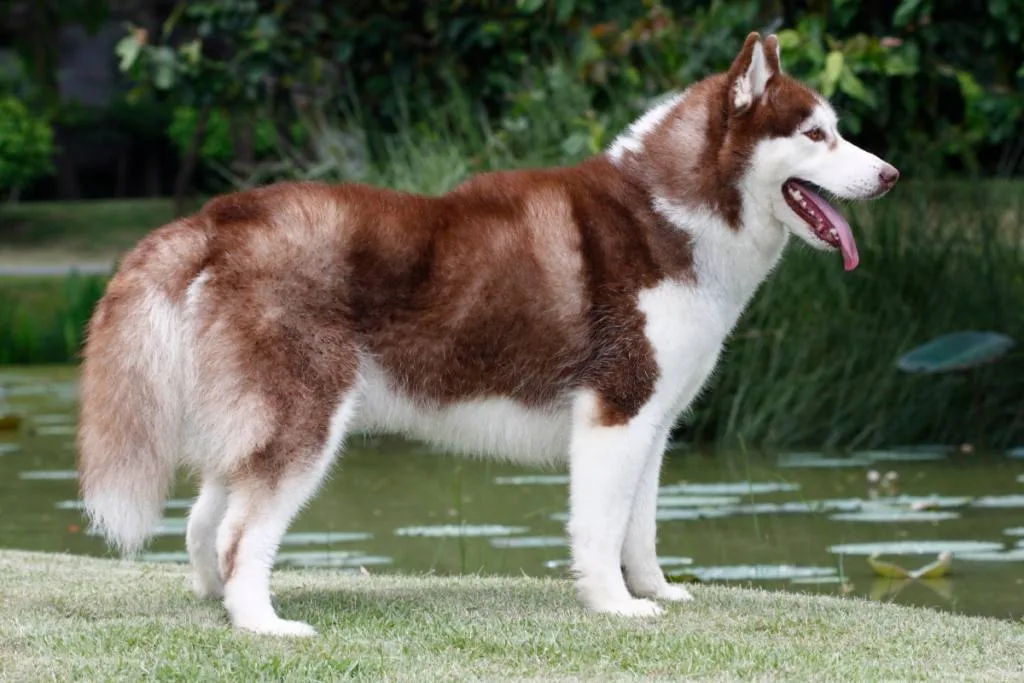
Siberian Huskies are probably the most common dog people think of when asked about dogs for snowy conditions.
Huskies are compact, well-muscled, medium-sized dogs. Their height is 20 to 23.5 inches (50 -60 cm), and their weight is 35 to 60 pounds ( 15 -27 kg).
They are easily identified by their striking colors and markings.
They have a thick double coat that protects them when they pull sleds across snow and ice in the Arctic.
Their tails are thickly furred and serve a critical function. When Huskies sleep, they often use their tail to cover their noses and faces to prevent frostbite.
They are generally good with children but have a high prey drive and cannot be trusted around smaller animals.
Huskies are friendly dogs and seldom show aggression to people.
They have high social needs and function best when kept in packs.
Knowledgeable Husky owners state that one husky is never enough. Huskies instinctively seem to prefer other Huskies.
They require the rigid hierarchy found in packs and can challenge for dominance if they think there is an opportunity.
They will do this with people if they do not have a canine pack. Managing a pack is not for inexperienced dog owners and requires advanced canine knowledge.
Huskies are high-energy dogs. They were bred to run for miles pulling sleds.
It is critical for them to have these exercise needs met. If they are not exercised enough and become bored, they are destructive and devise ways to escape their yards.
These are not dogs that are easily kept as pets. They have special needs, and even experienced dog owners may struggle with the challenges posed by Siberian Huskies.
Source: AKC
Be sure to check out tons of great additional information about Huskies in the articles below:
Can German Shepherds and Huskies Live Together?
German Shepherd Husky Mix: The Gerberian Shepsky
13 Most Dangerous & Banned Dog Breeds You Should Know
4. White Swiss Shepherds
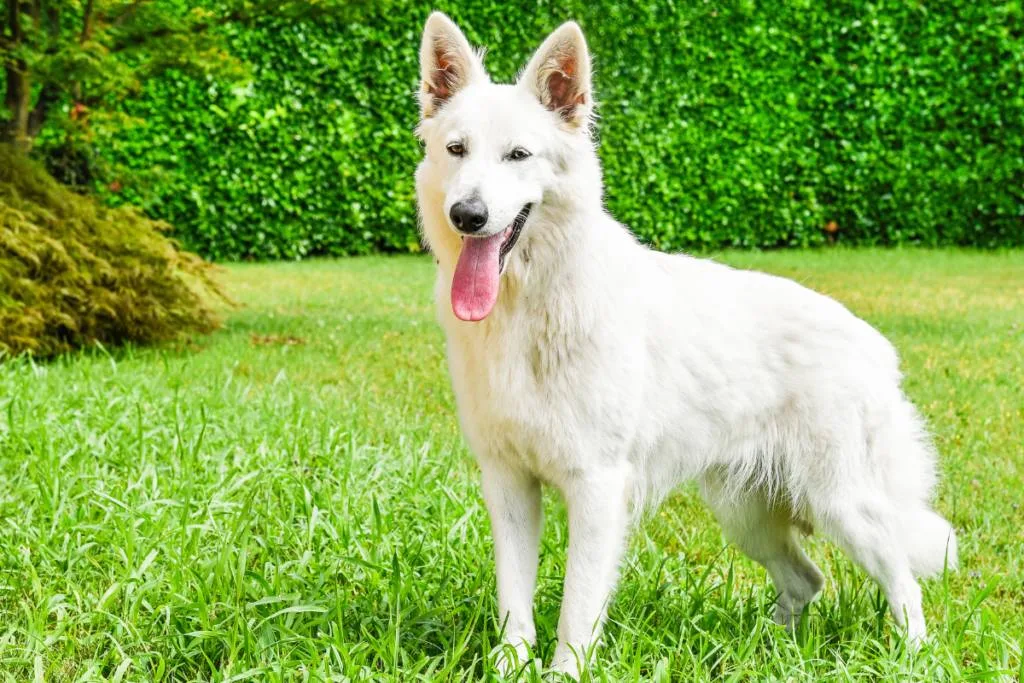
White Swiss Shepherds are similar in appearance to German Shepherds and have the same origins.
They have a thick, dense double coat that can be either medium-length or long.
Their beautiful white coats are ideally adapted to cold climates.
Their height is 20 to 26 inches (53-66 cm), and their weight range is 55 to 88 pounds (25 – 40 kg).
They are intelligent dogs, and most kennel clubs describe them as having a balanced, lively temperament.
Swiss Shepherds are eager to please, making training them a pleasure.
They have recently become popular as service dogs for people with disabilities. This is mostly due to their amenable temperaments and willingness to work with people.
Swiss Shepherds form close bonds with their owners and are good with children.
They fall into to the herding group and can be trained not to chase small animals or birds.
They are suitable dogs for first-time owners who are prepared to invest time in training.
Swiss Shepherds need interaction with their family and are unhappy and depressed when left alone for extended periods.
Source: UK Kennel Club
5. Pomeranian
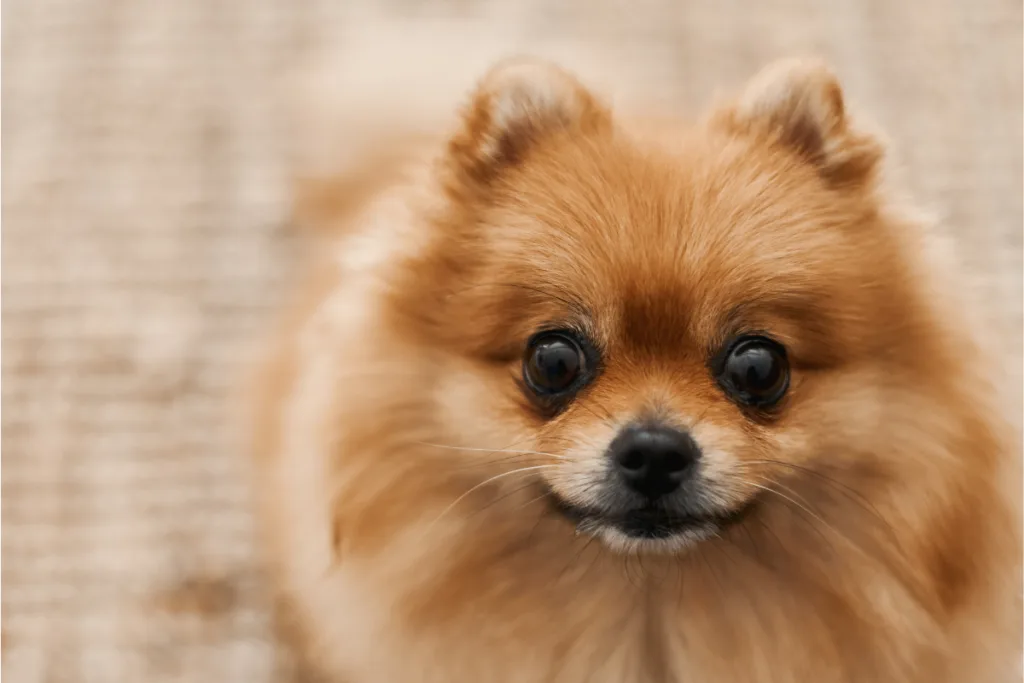
The Pomeranian belongs to the toy group of dogs. This appealing little dog is 6 to 7 inches (15 -18 cm) and weighs 3 to 7 pounds (1.3 -3 kg).
Pomeranians have a heavy double coat that effectively keeps the dog warm in freezing weather conditions.
The undercoat is fluffy and dense with a profuse long overcoat that comes in various colors.
They are lively, inquisitive little dogs with keen, sharp brains. They excel at learning tricks and are the perfect companion dog.
Their small size makes them suitable for all housing types, including apartments.
Pomeranians are suitable for first-time dog owners. They can be good with children if they are taught to respect the dog.
The dog’s small size makes them vulnerable to injury from children. It is essential to instruct children to be gentle with their dog.
Source: AKC
You’ll find more great information on Pomeranians (Pom Poms!) here:
20 Most Loyal Dog Breeds That Attach To One Person
Dogs That Adapt To Cold And Hot Weather
In some regions, the weather may fluctuate to extremes, being icy at times and having uncomfortable heat in others. Some dogs can adapt to these extremes.
1. Labrador Retrievers
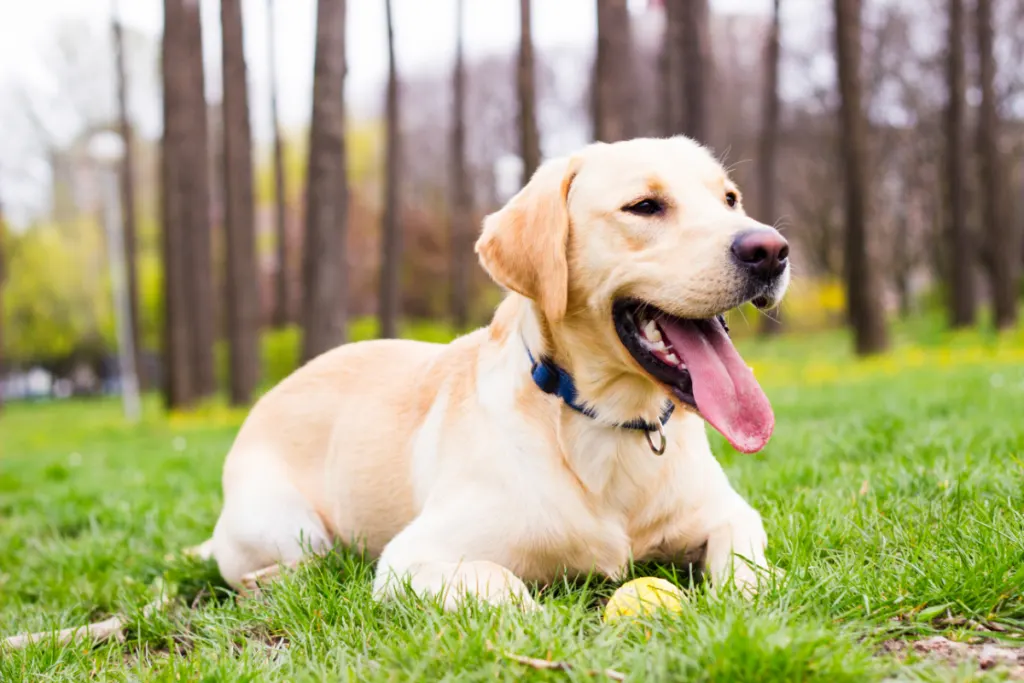
Labrador Retrievers are without a doubt one of the most popular dogs all over the world.
They have a water-resistant double coat that is either black,chocolate or yellow. If you have ever washed a Labrador, you will know it takes some effort to get them wet to the skin.
Their double coat, although short, allows them to cope relatively well with cold conditions.
They are used in many countries to retrieve waterfowl from cold rivers and lakes.
Labradors love swimming and playing in the water.
In hot seasons of the year, they will spend a lot of time swimming if they have access to water. This helps keep them cool when the mercury is soaring.
Labradors are people-loving dogs, and you can learn lots more about them by checking out the article below:
Labradors Are Great With Kids, And Here’s Why!
and this…
Here’s Why Labradors Are So Popular The World Over
or this…
Why Would A Labrador Bite? Signs To Watch For
lastly, this!
Can Labradors Be Left Alone All Day? How Long Is Too Long?
2. German Shepherds
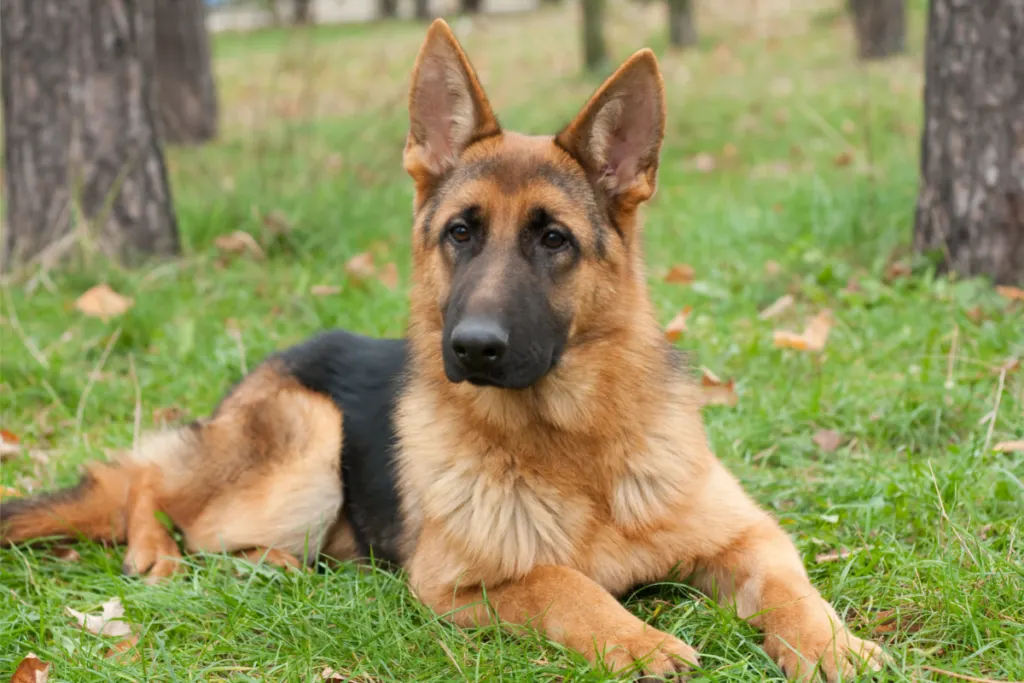
German Shepherds have a double coat that can be short, plush (medium), or long.
The double coat protects them when the weather is cold. Long-haired German Shepherds are better adapted to cold weather than shorthaired ones.
Generally, German Shepherds are hardy dogs, and their coats will thicken to adapt to changing weather conditions.
Their undercoats are shed during spring to keep them cool during the hot summer months.
This is a large breed dog that is highly intelligent.
They are sensitive and need the companionship of people. you can learn more about German Shepherds and how they relate to other dogs by clicking here.
Also, be sure to take a look at the informative articles below for more climate related information pertaining specifically to German Shepherds:
What Temperatures Can German Shepherds Tolerate?
Can You Keep a German Shepherd Outside?
Final Thoughts
It is vital to remember that although dogs may be adpated to cope with hot or cold weather, they should not be left outside to endure these extremes.
They need to be kept safe from harsh weather conditions, as they can still suffer ill effects from it.
Dogs are always happiest when they feel safe and are in the company of their owners.
